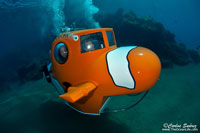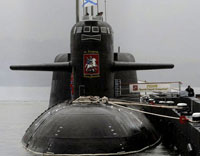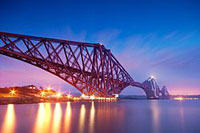 Harold Hackett of Prince Edward Island started throwing bottles with messages inside into the Atlantic Ocean in 1996. Since then he has cast 4,800 bottles into the sea and has received 3,100 responses. He has received letters back from Africa, Russia, Holland, the UK, France, Scotland, Ireland, parts of New England, Florida, Norway and even the Bahamas. His response rate may be better than the average “Friend” request rate on Facebook. Click the link below for a BBC interview of Mr. Hackett.
Harold Hackett of Prince Edward Island started throwing bottles with messages inside into the Atlantic Ocean in 1996. Since then he has cast 4,800 bottles into the sea and has received 3,100 responses. He has received letters back from Africa, Russia, Holland, the UK, France, Scotland, Ireland, parts of New England, Florida, Norway and even the Bahamas. His response rate may be better than the average “Friend” request rate on Facebook. Click the link below for a BBC interview of Mr. Hackett.
 In February 2010, the sail training ship Concordia sank off the coast of Brazil. At the time, the captain said that the ship was hit by a “microburst,” also known as a white squall, a violet storm which struck the ship so rapidily that there was no time to react. A report issued today by the Transportation Safety Board of Canada, however, blamed human error caused by poor training for the capsize and sinking of the ship.
In February 2010, the sail training ship Concordia sank off the coast of Brazil. At the time, the captain said that the ship was hit by a “microburst,” also known as a white squall, a violet storm which struck the ship so rapidily that there was no time to react. A report issued today by the Transportation Safety Board of Canada, however, blamed human error caused by poor training for the capsize and sinking of the ship.
Poor training standards to blame in SV Concordia sinking
Continue reading
 Two hundred and fifty three years ago today, Horatio Nelson was born in in Burnham Thorpe, Norfolk, the sixth of eleven children. He went to sea at 12 on a ship commanded by a maternal uncle. He would become the greatest naval commander in British history, dying in 1805 at the battle of Trafalgar, his great victory, where the Royal Navy soundly defeated the combined fleets of the French and Spanish navies.
Two hundred and fifty three years ago today, Horatio Nelson was born in in Burnham Thorpe, Norfolk, the sixth of eleven children. He went to sea at 12 on a ship commanded by a maternal uncle. He would become the greatest naval commander in British history, dying in 1805 at the battle of Trafalgar, his great victory, where the Royal Navy soundly defeated the combined fleets of the French and Spanish navies.
The Royal New Zealand Navy is also celebrating its 70th birthday. On October 1, 1941, the The New Zealand Division of the Royal Navy became the Royal New Zealand Navy. The 70th Anniversary celebrations will include a visit to Wellington by ten navy ships. Festivities start today and run through Monday. These will not be the only excitement in Wellington this weekend, however. The New Zealand All Blacks will be competing in a Rugby World Cup match against Canada. A Festival of Carnivale will also be taking place as will a “rural weekend” event including sheep shearing, sheep dog trials, sheep racing and wood chopping. Wow. A busy and eclectic weekend indeed.
We recently posted about personal submarines. In browsing around in that market, we came across the “Seabreacher” and thought that it deserved a separate look. The Seabreachers by Innerspace are definitely the most brilliant, crazy, or perhaps a bit of both, personal watercraft out there. They are snorkel fed submersibles which can travel at up to 55 mph on the the surface and around 20 mph just below it. And just for the fun of it, or perhaps merely to mess with the minds of nearby whale watchers, one model looks rather like an orca. Additionally, the “orca” model, Seabreacher Y, can be outfitted with riding pegs and a handlebar attachment to allow a stunt man to ride on the back and perform tricks. The Seabreacher X looks a bit like a shark. The non-orca or shark Seabreachers look like something from a James Bond movie. They also have a “Dolphin” Seabreacher which Innerspace has used as a “a research and development platform ” but is not in commercial production. Prices start at US$ 65,000 for a standard model and at US$ 81,000 for the orca-like Model Y.
Killer Whale Seabreacher Watercraft
[iframe: width=”480″ height=”360″ src=”http://www.youtube.com/embed/7SUHOjnkmlI” frameborder=”0″ allowfullscreen]
Seabreachers are Coast Guard approved as personal watercraft. The manufacturers “strongly recommend that a support boat is present whenever you operate a Seabreacher. This is not as much for the Seabreacher but more to help keep other boaters or water users from coming too close to the vessel when it is operating. We also recommend having radio communication between the vessel and chase boat as an added precaution. We continue to use a support boat every time we go out, even after ten years of operation.”

Sport Sub submersible
Slate.com recently recently featured and article, You-Boat, Can you buy your own submarine?. They noted that drug smugglers had their own submarines to sneak cocaine and other drugs north. If they had subs why couldn’t we all own a personal submarine? They then went onto say that, “around $600,000 will get you an entry-level, winged submersible without a pressurized cabin. If you’re willing to spend $2 million, you can buy a two-person submersible with a see-through acrylic dome.” That seemed awfully expensive for a personal submarine. So we decided to do some shopping. You an get started for a lot less than $600,000.
Continue reading

Jamaran Mowj Class multi purpose light guided missile frigate
The Iranian state-run Islamic Republic News Agency reported Tuesday, that Adm. Habibollah Sayari of the Iranian Navy announced that Iran would be sending ships near US waters. Iran is also planning to send ships to the Gulf of Aden to help counter piracy in the region. The interesting question is, what ships do they have to send?

Photo: Juergen Braker
Just over a week ago we posted about the hijacking of the product tanker 45,000 DWT tanker, Mattheos I, with a crew of 23, off Benin in the Gulf of Guinea. Last Saturday, the ship and crew was released. No ransom was paid. The pirates stole as much of the diesel fuel cargo as they could and fled. One crew member was reported to be slightly injured, but otherwise the crew is said to be fine.
Why is piracy inthe Gulf of Guinea so different from piracy off the coast of Somalia?
Continue reading

Photo: John Lee / Aurora Select
When Diana Nyad was stopped by repeated jellyfish stings in her most recent attempt to swim between Cuba and Florida, it brought to mind two articles, one about the discovery of the “immortal jellyfish” and another which raised the question whether the world’s oceans will become dominated by jellyfish.
As global warming and pollution degrade the oceans are we being faced by a jellyfish apocalypse? Consider – on the night of December 10, 1999, 40 million people, abruptly lost power on the Philippine island of Luzon, home to the capital, Manila. Was it a terrorist attack? A coup? No, it was masses of jellyfish blocking cooling lines of a local power plant. An editorial in the Philippine Star noted, “Here we are at the dawn of a new millennium, in the age of cyberspace, and we are at the mercy of jellyfish.”
Almost three miles beneath the surface of the Atlantic, deeper than the Titanic, Odyssey Marine has located the wreck of the S.S. Gairsoppa, which was torpedoed in February of 1941 by a German U-boat. When she sank, the ship was loaded with silver, pig iron and tea. The 240 tonnes of silver aboard are believed to be worth aproximately $200 million (around £155 million.) Odyssey plans to begin recovery operations in the spring which, if successful, will be the deepest and largest retrieval of a precious cargo lost at sea in history.
Shipwreck of SS Gairsoppa discovered with £155m silver haul onboard
Thanks to David Rye, Phil Leon and Irwin Bryan for passing the story along.
 In August, Diana Nyard attempted to become the first person to swim from Cuba to Florida without the aid of a shark cage. She gave up that attempt after 29 hours of swimming when adverse winds blew her off course. Late last week she attempted the swim for a second time but was stopped this time by jellyfish, specifically multiple Portuguese Man o’ War stings. Two thirds of the way through her second recent attempt at swimming from Cuba to Florida, 62-year-old Diana Nyad was advised to get out of the water by her doctors after being stung repeatedly by jellyfish and Portuguese Man o’ War. Nyad had covered about 92 statute miles over the 40 hour swim, two-thirds of the journey from Cuba to Florida, but her doctors were concerned that toxins were building up in her body from the repeated stings.
In August, Diana Nyard attempted to become the first person to swim from Cuba to Florida without the aid of a shark cage. She gave up that attempt after 29 hours of swimming when adverse winds blew her off course. Late last week she attempted the swim for a second time but was stopped this time by jellyfish, specifically multiple Portuguese Man o’ War stings. Two thirds of the way through her second recent attempt at swimming from Cuba to Florida, 62-year-old Diana Nyad was advised to get out of the water by her doctors after being stung repeatedly by jellyfish and Portuguese Man o’ War. Nyad had covered about 92 statute miles over the 40 hour swim, two-thirds of the journey from Cuba to Florida, but her doctors were concerned that toxins were building up in her body from the repeated stings.
A fascinating look at the research of Denise Herzing, who has been studying dolphins in the Bahamas for 25years. Next year she is beginning an attempt to use technology to engage in two way communication with dolphins.
[iframe: width=”480″ height=”373″ frameborder=”0″ scrolling=”no” marginheight=”0″ marginwidth=”0″ id=”nyt_video_player” title=”New York Times Video – Embed Player” src=”http://graphics8.nytimes.com/bcvideo/1.0/iframe/embed.html?videoId=100000001061693&playerType=embed”]
Ann Weaver is a researcher who has been studying dolphins in Boca Ciega Bay, with a particular focus on how to to minimize the impact of local construction projects on the dolphins.
 Today, we have three posts about dolphins and humans interacting. I went to high school on the Gulf Coast of Florida, which has some of the largest bottlenose dolphin populations in the world. When I am in Florida visiting family, I always look forward to kayaking between the mangrove islands of Boca Ciego Bay where pods of dolphin and porpoise fish and play along the edges of the channels, often swimming around and under my kayak. Magnificent creatures. On Friday, Warner Brothers released Dolphin Tale, a movie about the first dolphin ever to be fitted with a prosthetic tale. It is set in Clearwater, Florida, not far from where I went to high school. A review:
Today, we have three posts about dolphins and humans interacting. I went to high school on the Gulf Coast of Florida, which has some of the largest bottlenose dolphin populations in the world. When I am in Florida visiting family, I always look forward to kayaking between the mangrove islands of Boca Ciego Bay where pods of dolphin and porpoise fish and play along the edges of the channels, often swimming around and under my kayak. Magnificent creatures. On Friday, Warner Brothers released Dolphin Tale, a movie about the first dolphin ever to be fitted with a prosthetic tale. It is set in Clearwater, Florida, not far from where I went to high school. A review:
Continue reading

Photo: DR
Tommorrow, the Charente-Maritime/Bahia Transat 6.50 sets off from La Rochelle, France bound for Salvador de Bahia, Brazil via Funchal, Madeira. Roughly eighty sailors from sixteen countries will sail the Open/Mini 6.5, a 21 foot long ocean racer, across the Atlantic.
One experienced competitor, Jean-Marc Allaire, will not be sailing. Last week, his boat, Karantez VI, was found under full sail off Cap Ferret with no one aboard. A short time later a body was found on Lège-Cap-Ferret’s beach, which was identified as Allaire. Allaire was on his way to the start of the race when he apparently fell overboard. The Charente-Maritime race began 34 years ago in 1977, which was also the year of Jean-Marc Allaire’s birth. Our sincere condolences to his family and friends.
Thanks to Michael Kingdom-Hockings for pointing out the story.

Photo: RIA Novosti. Sergey Guneev
What is interesting about this story is how it has been reported. Here is what we know: The fishing boat, Donets, ran into the Russian nuclear submarine, Svyatoy Georgiy Pobedonosets (St. George the Victor,) in the Avachino Bay on the far eastern Kamchatka Peninsula, causing minor damage, K-433 Svyatoy Georgiy Pobedonosets (St. George the Victor) is a Delta III class nuclear-powered submarine that has been in service with the Russian Navy since 1980.
Most other details of the story get a bit hazy.
Continue reading
 Happy autumnal equinox. The first day of Fall. I know of no good sailor’s tradition for the autumnal equinox. It seems to be too busy a time to stop for such foolishness. Everyone is trying to get the last trips of the season in or is already getting ready for winter. In the Northeast, I always wondered why I didn’t have at least as much sense as the geese, who were all flying south to warmer climes.
Happy autumnal equinox. The first day of Fall. I know of no good sailor’s tradition for the autumnal equinox. It seems to be too busy a time to stop for such foolishness. Everyone is trying to get the last trips of the season in or is already getting ready for winter. In the Northeast, I always wondered why I didn’t have at least as much sense as the geese, who were all flying south to warmer climes.
I would like to suggest an autumnal equinox tradition of putting on warm socks. There is a sailor’s ritual of burning one’s socks at the vernal equinox socks, presumably the socks one wore all winter. (See: Spring equinox – Sailors burn their socks) Putting on a warmer pair now, has a certain seasonal symmetry. If anyone has other, and no doubt better, autumnal equinox traditions I would love to hear of them.
All sailors should be watching the sky this afternoon and evening. NASA’s Upper Atmosphere Research satelitte, about the size of a bus and weighs 6.5 tons is expected to plunge to earth sometime this afternoon or early evening Eastern time. NASA isn’t sure where it will land but thinks that it will miss North America. Odds are that the space junk will land in the ocean. (UPDATE: 2:PM EST – NASA now thinks that it may land in North America after all.) Let us hope that crashing satelittes do not become an equinox tradition. To have a satellite fall on the first day of Fall seems wholly unnecessary.

The Forth Bridge - Painted at Last
I recently learned a new figure of speech – “like painting the Forth Bridge,” which refers to a job which is never completed. Or at least it used to mean that. The Forth Bridge is a cantilever railway bridge over the Firth of Forth in the east of Scotland. It is is a marvel of British engineering, so large that for the last 121 years, teams of painters have been continuously painting the bridge. The job took so long that by the time the painters were finished, they needed to start again. Now however, the bridge will be coated with glass flake epoxy paint, which is similar to that used in the offshore oil industry. This improved paint technology will mean that the bridge will not require painting for 25 years. A good figure of speech bites the dust, to coin a phrase.
Continue reading
 The US military’s previous policy toward gay service members; “don’t ask, don’t tell; officially came to an end yesterday. Naval officer, Lt. Gary Ross, chose the day to marry his partner of eleven years, Dan Swezy, in Duxbury, Vt. In Tulsa, Oklahoma, Marine recruiters who had been invited to set up a recruiting booth on the first day of the end of “don’t ask, don’t tell” at the Dennis R. Neill Equality Center, a gay community center, were pleasantly surprised by the reception, which was friendly, even if the number of potential recruits was modest. Over the 18 years which DADT was official policy, the US Navy, Marines and Coast Guard discharged over 4,200 gay officers and enlisted personnel. The Army and Air Force discharged more than 6,000. Thanks to Alaric Bond for passing along one of the articles.
The US military’s previous policy toward gay service members; “don’t ask, don’t tell; officially came to an end yesterday. Naval officer, Lt. Gary Ross, chose the day to marry his partner of eleven years, Dan Swezy, in Duxbury, Vt. In Tulsa, Oklahoma, Marine recruiters who had been invited to set up a recruiting booth on the first day of the end of “don’t ask, don’t tell” at the Dennis R. Neill Equality Center, a gay community center, were pleasantly surprised by the reception, which was friendly, even if the number of potential recruits was modest. Over the 18 years which DADT was official policy, the US Navy, Marines and Coast Guard discharged over 4,200 gay officers and enlisted personnel. The Army and Air Force discharged more than 6,000. Thanks to Alaric Bond for passing along one of the articles.
 Updates on three previous posts: On Monday, Able Seaman Ryan Donovan was sentenced to life imprisonment after pleading guilty to murdering a senior officer on board the HMS Astute last April. Submariner’s grudge turned proud day into tragedy
Updates on three previous posts: On Monday, Able Seaman Ryan Donovan was sentenced to life imprisonment after pleading guilty to murdering a senior officer on board the HMS Astute last April. Submariner’s grudge turned proud day into tragedy
British tourist Judith Tebbutt, kidnapped last week from an exclusive Kenyan resort, is believed to be being held in central Somalia, by a pirate gang. Her husband, David Tebbutt, was killed in the pirate attack last week. British Tourist, Kidnapped in Kenya, May Be in Central Somalia
The containership MSC Luciana which ran aground on Monday on a sand bar in the Westerschelde was towed off the sand bank at high tide that evening with the assistance of around nine tugs, and proceeded to Zeebrugge for underwater hull inspection.
Thanks to Dirk Bal and Alaric Bond for providing updates.
For something so relatively new, we take the internet very much for granted. The first graphical web browser is less than 20 years old. Nevertheless, the internet seems ubiquitous in most of our lives. But on a world that is over 70% ocean, how do we communicate from one continent to another? Primarily, by sub-sea cable. TeleGeography has put together a map of the submarine cables that link us together on-line.

